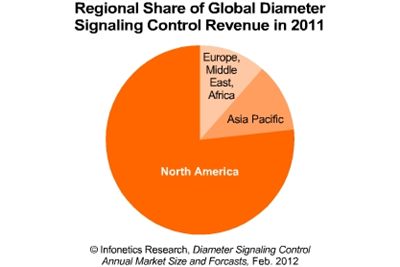キャンベル、カリフォルニア州、2012年2月8日-通信市場の専門調査会社Infonetics Researchは2月3日金曜日、Diameter Signaling Control の世界および各地区の市場規模と予測に関するレポートを発表した。これは、成長しているDiameter signaling 市場に関する最初の詳細な分析である。

レポートの主張は次のとおりである。Diameter protocol は事業者ネットワークのための次世代信号プロトコルとして開発されたものであるが、その利用に関しては初期段階である。また、多くの加入者がIPを基盤とする全てのモバイルネットワーク(例:LTEやIMS)からあふれ出てくるにつれて、Diameterトラフィックは堅調な成長を続けるだろう。ネットワーク事業者は、Diameter トラフィックの発展に伴う課題とネットワークへの影響について認識しつつある。
アナリストノート
「全てのIPを基盤とするネットワークの信号および制御プレーンにおけるDiameter トラフィックは成長の継続が確約されており、事業者はトラフィックをより効率的に管理、計測するためにDiameter signaling controllers を活用するようになる」と、Infonetics Research のVoIPおよびIMS担当の上級アナリストDiane Myersは述べている。「信号トラフィック増加の主な要因は、モバイルブロードバンドネットワーク、新たな機器やスマートフォン(ハイエンド商品であるアップルのアイフォーンから廉価なHuawei の機器、両者の中間機器すべて)、モバイル用アプリ、とりわけ常時使用あるいは電源オンされているゲームアプリやフェイスブックのようなSNSアプリの急速な利用増加である。電池節約機器でさえも、モバイルフォンを電源再開したときに信号を発生させるため、Diameter信号トラフィックの混雑をもたらす。」
Myers はさらに付け加える。「LTEネットワークが拡大してより多くのトラフィックがネットワークに流れるにつれて、 Diameter signaling controller市場は急速に発展するだろう。Infonetics Research社では、LTEネットワークおよびLTE加入者のグローバルレベルの成長と同様に、2016年にかけて事業者売上が年平均増加率106%で成長すると予想している。」
DIAMETER SIGNALING CONTROL 市場ハイライト
- いくつか話題になったネットワーク障害はDiameter信号の弱みをさらけ出したほか、過度の信号トラフィックが事業者のネットワークに対して弱みとなることが明らかとなった。その例として、2011年におけるVerizon Wireless' のLTE ネットワーク障害、Telenor の18時間にわたって通話およびテキストメッセージ送信ができなかったLTE ネットワーク障害、2012年1月にアンドロイド端末でユーザーが利用していないのに制御シグナルでネットワークを読み込んだNTTdocomo の障害がある。
- 2011年にInfoneticsはDiameter signaling controllersと分類される新たな商品カテゴリーを導入した。この目的はDiameterトラフィックの混雑を緩和するため、およびネットワーク内の信号および制御プレーンを効率的な規模にするためである。
- Diameter signaling control において主導権を握ろうとする事業者は多く、Tekelec はこの草創期の市場において一歩リードしている(特定の事業者シェア情報については、今後のInfonetics 発行レポートで提供される予定である)。
- Infoneticsは2012年末までに少なくとも15の事業者がdiameter signaling controllersを所有すると予想しており、その時には業界のリーダーが固まり始めるだろう。
- 現在のところ、Diameter signaling controller関連の売上の大半は、LTEネットワークの採用で先導的な地位にある北米からのものである。しかしながら、LTEが成長を続けているアジア太平洋、EMEAにおいても市場の成長がみられる。
Infonetics' new Diameter signaling report provides worldwide and regional market size and forecasts through 2016 of manufacturer revenue and transactions-per-second licenses for Diameter signaling controllers, which provide centralized routing, traffic management, and load-balancing between Diameter and non-Diameter elements within IMS and mobile broadband networks. The accompanying Diameter signaling control analysis report includes market top takeaways, market trends and drivers, an overview of Diameter signaling, use cases, forecast notes, regional trends, and vendor activity. Diameter signaling control vendors tracked: Acme Packet, Alcatel-Lucent, Alepo, Amdocs, Aricent, Comptel, F5 Networks, Intellinet, Openet, Tekelec, Traffix, and others. Regions tracked: North America, Asia Pacific, EMEA (Europe, Middle East, Africa), and Central and Latin America
(原文)
Mobile broadband, smartphones, LTE drive Diameter signaling controllers to 106% CAGR through 2016
CAMPBELL, California, February 8, 2012-Communications market research firm Infonetics Research (www.twitter.com/infonetics) on Friday released its Diameter Signaling Control Worldwide and Regional Market Size and Forecasts report, its first in-depth analysis of the emerging Diameter signaling market.
The report contends that the Diameter protocol, which was developed as the next-generation signaling protocol for operator networks, is in the early stages of being utilized, and that Diameter traffic continues to grow steadily as more subscribers run over all IP-based mobile networks (i.e., LTE and IMS). Network operators have just begun to recognize the scaling challenges associated with this buildup of Diameter traffic and the impact on their networks.
ANALYST NOTE
"Diameter traffic in the signaling and control plane of all-IP based networks is guaranteed to continue to increase, forcing operators to utilize Diameter signaling controllers to more efficiently manage and scale that traffic," affirms Diane Myers, directing analyst for VoIP and IMS at Infonetics Research. "The key drivers behind the increase in signaling traffic is the fast-escalating use of mobile broadband networks, new devices and smartphones (from high-end Apple iPhones to less expensive Huawei devices and everything in between), and mobile applications, particularly gaming and social networking apps like Facebook that are in constant use or always on. Even battery-saving gadgets can spur signaling each time they reactivate a mobile phone, adding to Diameter signaling traffic congestion."
Myers adds, "As LTE networks expand, driving even more traffic to the network, the Diameter signaling controller market will take off rapidly: we forecast a 106% compound annual growth rate in vendor revenue through 2016, in line with global growth in LTE networks and LTE subscribers."
DIAMETER SIGNALING CONTROL MARKET HIGHLIGHTS
- Several high-profile network outages have exposed weaknesses in Diameter signaling and proved how debilitating excessive signaling traffic could be to operator networks, including Verizon Wireless' LTE network crash in early 2011, Telenor's 18-hour LTE network outage that prevented calls from connecting and text messages from being delivered, and NTT DoCoMo's outage in January 2012 that was attributed to Android devices, which load the network with control signals even when users are inactive
- In 2011 a new category of products, which Infonetics classifies as Diameter signaling controllers, was introduced to alleviate Diameter traffic congestion and allow the signaling and control plane within networks to efficiently scale
- There are a number of vendors jockeying to play a role in Diameter signaling control, and Tekelec has an early lead in this nascent market (specific vendor market share standings will be provided in future editions of Infonetics' report)
- Infonetics expects at least 15 vendors to have diameter signaling controllers by the end of 2012, when market leadership will begin to take shape
- Today the majority of Diameter signaling controller revenue comes from North America, due in large part to leading LTE network deployments; however, there is growing activity in Asia Pacific and EMEA as LTE continues to expand in those regions

